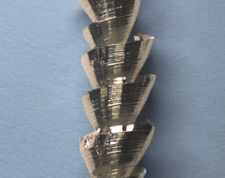- 01: Introduction
- 02: History
- 03: Propellants, Firearms, and Ammunition Development
- 04: Modern Firearms Manufacture
- 05: Small Arms Ammunition
- 06: Evidence Handling Procedures
- 07: Equipment and Instrumentation
- 08: Examination of Firearms
- 09: Cartridge and Shotshell Examination
- 10: Characterization and Evaluation of Fired Projectiles
- 11: Bullet Comparison and Identification
- 12: Gunshot Residue and Distance Determination
- 13: Toolmark Identification
- 14: Communicating Results
- Resources


Cutting Operations
Home > Toolmark Identification > Tool Manufacture > Cutting Operations

Deep hole shavings
Metal-forming operations, using conventional machine tools, involve the removal of metal using a cutting tool of a greater hardness than the workpiece (the piece of metal being formed). When cutting tools are used on metal, the cutting edge of the tool brings a large amount of force to bear at a very small point on the workpiece. When that amount of force exceeds the forces that hold the crystalline grain structure of the metal together, that structure fails along the edges of the metallic crystals.
The cumulative effect of these failures in the crystalline grain structure is to produce chips of metal of various types:
| Types of Metal Chip | |
| Chip Type | Description |
Continuous chips (long ribbons of metal) |
Typically found in machining a ductile metal with a sharp cutting tool, resulting in a fine surface |
Discontinuous chips (segmented chips) |
Break up into particles; associated with brittle metals and a coarser result on the surface of the workpiece |
Continuous chips with a built-up edge |
Accumulate tiny particles that weld to the workpiece, producing coarse surfaces on the workpiece. This often occurs if the cutting tool begins to dull |

Metallic drill shavings
The removal of these chips results in a machined surface bearing unique characteristics – subclass or individual.
The relative fineness or coarseness of this surface depends on variables that can be controlled by the machinist, including these:
- Brittleness or ductility of the workpiece (e.g., cast iron is brittle, brass is very ductile)
- Quality of the cutting tool
- Adjustment of the cutting tool for the depth of the cut
- Sharpness of the cutting tool
- Speed at which the workpiece moves relative to the cutting tool (feed rate)
- Angle of the cutting tool relative to the workpiece
- Speed of the cutting tool
- Condition of the edge of the cutting tool
- Temperature of the workpiece and cutting tool (usually controlled using coolant fluids)
In most operations, a mechanical device called a jig is used to hold the workpiece and guide the tool as it shapes the metal.
Cutting Tools

Cutting tool configurations
Click for larger imageThe various cutting tools use the chip-forming process. The cutting edges of the tools are arranged in a wide variety of single-point and multi-toothed configurations, depending on the specific metal removal task.




